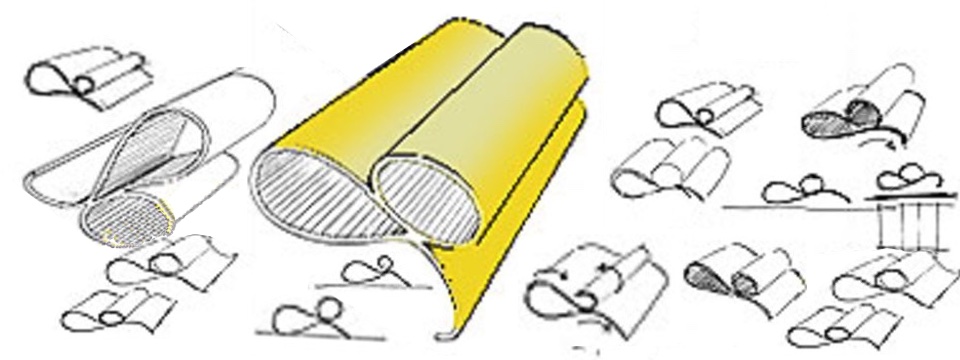Marille el sugo con piselli
Design a me a Pasta
A search for an interesting pasta recipe came up with “Marille el sugo con piselli” in the translated German version “Viva la Pasta” of an English cookery book “Passion for Pasta” written by Antonio Carluccio, – a collection of his favorite recipes.
Antonio, together with his wife Priscilla ran the famous “Neal Street Reastaurant” in London’s Covent Garden district. The restaurant started by Sir Terence Conran in 1971 was taken over by the Carluccio family in 1984 and was forced to close down March 2007 after 36 years of trading, due to plans for a more lucrative albeit for some unnecessary redevelopment programme by the building’s landlords. Frequented for the most part by customers from the world of Arts, Media and Design, they were served excellent Italian food created by Antonio. Wild mushroom soup, crab ravioli and Bollito Misto amongst the signature dishes. Antonio learnt his passion for mushrooms from friends of his father in the hills around the Piedmont family home of his youth.

So what’s all this got to do with a recipe for pasta with peas and fried stripes of bacon in a cheesy cream sauce you may well ask – and rightly so . . . the plot thickens . . . and so will the sauce if you’re not careful! Great designers began to get in on the act of pasta design. Industrial designer for Fiat and Alfa Romeo, Giorgetto Giugiaro, in 1983 designed a new pasta shape called ‘Marille’. This looked like an ocean’s wave. However it was not a success and subsequently withdrawn from the market.
“The Voiello company had very clear ideas in mind: either the pasta would be designed by a “technological” designer such as Giugiaro, and thus be produced by means of a new type of extrusion molding, or it would be poorly and simply shaped, and in that case they would chose Bruno Munari. We presented twelve designs, they chose five and passed them on to product engineers. We were invited to Naples in a fancy restaurant: the pasta had been tested with all kinds of sauces. As far as the requirements, the pasta should not absorb too much sauce; it should increase its volume in water, in the sense that a dish of marille should weigh half a dish of spaghetti; at the dawn of the nouvelle cuisine, it should be decorative, “architectural”; it should, like all pastas, retain the sauce and let the water go; it should then be “palatable”, a technical term which indicates a positive reaction of the mouth to its taste. They organized a big vernissage in Milano at the Centrodomus, Mendini did the design. It was a good image campaign, for the company and for its president, but the production did not go on long enough. The pasta was only distributed in a few places and people were not able to find it. Moreover, it it took a few more minutes to cook and this was a discrimination point. But I owe my popular fame to that pasta, I got even published on Newsweek, isn’t it funny?”
What do the following cars have in common: Alfa Romeo Alfasud, Audi 80, BMW M1, De Tomaso Mangusta, De Lorean DMC-12, Ferrari GT Bertone, Fiat Spider, Fiat Uno, Ford Mustang (2006), Lamborghini Cala, Lexus GS, Lotus Esprit, Maserati Quattroporte, Saab 9000, VW Golf, VW Passat and VW Scirocco? While we’re at it, what do these cars have in common with the Ducati 860 GT motorcycle and the following Nikon camera bodies: F3, F4, F5, F6? Give up? All of the above were designed by Giorgetto Giugiaro, one of the greatest industrial designers ever to come out of Italy. Giorgetto Giugiaro was named Car Designer of the Century in 1999. In November 1983 Voiello, an innovative pasta manufacturing company in Naples owned by the Barilla group, decided to break the mold, so to speak, and develop a “modern” pasta shape. The assignment went to car designer Giorgetto Giugiaro. Giugiaro submitted 12 designs from which one was picked to go into production. Giugiaro named his pasta Marille. Giugiaro took a very systematic approach to the problem. He realized that his new design should not absorb too much sauce and should increase its volume in water. The pasta should be both decorative and palatable. Of course his new shape should be produced by die extrusion. Here are the only sketches and photos of Marille pasta I have been able to find. Notice the dual-tubular design and the protruding tongue. Unlike conventional rigatoni, the grooves or rugosities were on the concave surfaces of the tubes presumably to give better adherence to the sauce.
Unfortunately, Marille did not remain in production very long. As far as I can determine, problems were encountered with uneven cooking of various parts of shape. Judging from the available sketches and the photo above, my guess is that the junction of the 3 elements would have cooked much more slowly than the rest of the shape. I think the Marille was, nevertheless, an innovative design even in spite of its troubles in hot water. I doubt much of it is still in existence but if you ever come across any, give us a shout.